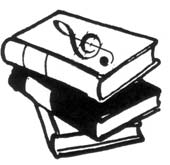|

This story was published in Radio Recall, the journal of the Metropolitan Washington Old-Time Radio Club, published six times per year.
Click here to return to the index of selected articles.
|
|
 AND THE BANDS PLAYED ON: AND THE BANDS PLAYED ON:
THE EXTRAORDINARY MUSICAL LANDSCAPE THAT WAS RADIO
A book review by Edgar Farr Russell III
© 2005
(From Radio Recall, October 2005)
Tell me, friend, what's your pleasure-- musically speaking, I mean? Do you enjoy tasty licks served up by Benny Goodman? Maybe classical music is more to your liking with Arturo Toscanini conducting the cream of musicians and singers? Perhaps as a teenager, you dug disc jockeys Martin Block or Alan Freed? Or have you just been missing the pleasing sounds of old radio favorites like Bing Crosby or Kate Smith? If you answered yes to any or all of my questions, then I have the best possible news for you!
Author Jim Cox has returned with a new book entitled Music Radio: The Great Performers and Programs of the 1920s through Early 1960s published by McFarland and Company, Inc. (380 pages; $55; hardcover; phone 800-253-2187 or on-line at www.mcfarlandpub.com) You might think a topic as important as music on radio would have been the subject of dozens of books. But like his pioneering presentation on Frank and Anne Hummert’s Radio Factory (reviewed in the October 2003 issue of Radio Recall), Cox illuminates a trail explored by relatively few.
How would you go about capturing such a vast story? Cox has chosen to weave a rich amalgam of musical subjects into 19 chapters. You’ll learn, in depth, about ten legendary shows including: The Bell Telephone Hour, The Bing Crosby Show, The Grand Ole Opry (still going strong) The Kate Smith Show, and Your Hit Parade. The other nine sections address a variety of program genres and performers such as: “The Big Bands”, “The Contests”, “The Disc Jockeys”, “The Horse Operas”, and “The Vocalists.”
If you’re a fan and/or researcher, you’ll find detailed biographical information on beloved singers, musicians, conductors, and announcers who performed in front of the microphone. Consider this: in a medium where it would be easy enough to read the music, we learn of the extreme dedication of singer Jessica Dragonette who refused to use sheet music on the air and instead committed “every word of every song to memory.” She was scrupulous in “preparing her solos, duets and ensemble melodies.”
Author Cox also sheds most welcome light upon the producers, directors, writers, and sponsors behind the scenes, who labored mightily to bring these programs regularly to millions. For example, listeners who think of sponsors as caring only about ratings will be surprised to learn of the "personal, almost paternalistic interest", spanning several generations, by the Firestone family to The Voice of Firestone. Indeed, Mrs. Harvey Firestone, Sr. wrote both of the theme songs used through the years.
Scholars will receive the kind of data on program ratings and on-the-air dates that they usually must laboriously extract from obscure trade publications or old and crumbling radio schedules In addition to chapter notes, bibliography, and index, this work is illustrated with a small number of fascinating photographs of famous personalities. Given that the faces of many of the performers and most of the production staff remained unknown to listeners, including a greater number of such photos would have brought an additional dimension to the program descriptions and biographies.
In the final analysis, however, the author does give the reader something even more special. With his gift for shaping the written word, Jim Cox vividly brings these shows to life again. As you come to the end of Music Radio, having become acquainted with numerous wireless classics and the talented individuals responsible for them, you’ll feel as if you are present at their creation, watching them take their first steps in a new medium, cheering them on as they boldly make their way into public acclaim, and then witnessing almost all of them, like old soldiers, just fading away. None of them, however, will ever truly be forgotten because the warm glow of our collective memories has been captured for all time in this superb volume.
Edgar Farr Russell, III is a writer, director, and actor whose work has appeared on National Public Radio, local cable television, and on stage. He is also a member of the Metro Washington Old Time Radio Club.
|